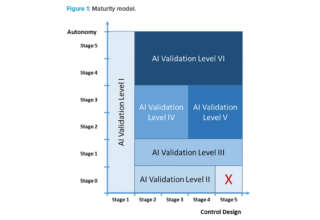
Digital art at Sotheby’s? The auction house is better known for selling canvases by Andy Warhol and Jean-Michel Basquiat for $100 million-plus than for showing what many collectors still regard as ephemera.
Yet the Sotheby’s S2 gallery in New York, normally used for exhibitions of contemporary art, is currently the site of a show featuring mostly young artists who rely on digital technology and who are not exactly household names. Surprisingly, most of the works on view take physical form. More significant, they also betray a broad generational anxiety about the technological future and the role of humans in it.
The catalyst for the show was a curious-looking sculpture tucked away in the Art + Technology Lab at the Los Angeles County Museum of Art.
A sleek, black plinth with a black screen in front and a record player perched incongruously on top, it was designed as a prototype for a 21st-century memorial. When David Goodman, the Sotheby’s executive in charge of marketing and digital development, saw it a couple of months ago, its screen was displaying the social media posts of a 25-year-old Miami bicycle enthusiast who had been killed in a roadside hit-and-run. A vinyl record played synthesized chimes, their tone determined by a computer analysis of the emotions those posts expressed — a major key if they were positive ones, a minor key if negative.
“I was pretty blown away by the piece,” Mr. Goodman recalled recently in his office at Sotheby’s headquarters in New York. “It also made me sad. I can’t ——
“Let me put it this way: It struck an emotional chord.”
Continue reading the main story

The sculpture, “Monument I,” had been created for a show about the Hereafter Institute, a fictional organization that now lives only online. It purports to arrange a digital afterlife for its “clients” — preserving their online presence and, through virtual reality, even the memory of their physical existence. On its website, the institute greets visitors with such deadpan sales pitches as, “What will death mean when our digital souls outlive our physical bodies?”
In fact, sculpture and institute alike were the work of Gabriel Barcia-Colombo, a 35-year-old New York artist and teacher at New York University’s Interactive Telecommunications Program. Working with a grant from Lacma, Mr. Barcia-Colombo invented the institute as a way of exploring the rituals of death in the digital age.
Now, at Mr. Goodman’s invitation, he has curated the digital art exhibition at Sotheby’s. The young artists in the show — several I.T.P alumni among them — tend to share, despite their immersion in digital technology, a profound ambivalence about where it is taking us. They also seem to share the “Black Mirror” sensibility behind the Hereafter Institute: The perception, endemic to the satirical British TV series, that technology has led us into a digital fun house where nothing is as it seems and everything is as we fear it might be.
The show at Sotheby’s, called “Bunker,” runs through Aug. 10. It includes Jeremy Bailey, a Toronto artist who merges Snapchat with art history, portraying individuals through an augmented reality lens in poses that recall famous portraits from the past. A digital C-print of his wife as she stares at a tablet that appears to be coming to life recalls Dante Gabriel Rossetti’s “Lady Lilith” gazing into a mirror.

“It’s the idea of looking at oneself through the technology of the day,” Mr. Bailey said by phone. An adjacent self-portrait shows him in the guise of the persona he has adopted — that of an obnoxiously ebullient naïf who proclaims himself a famous new media artist. “He believes deeply that technology can help, and yet technology consistently lets him down,” Mr. Bailey said of his alter ego. “So damn it, why doesn’t it deliver?”
Elsewhere in the show, you can don a virtual reality headset to navigate the childhood home of Sarah Rothberg, who reconstructed her experience growing up in Los Angeles from old photos and home movies. Or view lacy, metallic sculptures by Ashley Zelinskie — self-portraits whose surfaces are made up of the letters that spell out her genetic code. One piece — in a series called “Android” — has a cube embedded in the face; the cube’s surface is made up of the computer code that was used to generate it.

Ms. Zelinskie’s human-digital mash-ups are about “how we’re becoming one with our technology,” she explained in her studio in Bushwick, Brooklyn — a small, crowded loft with NASA fliers and “Star Trek” posters taped to the walls. In theory, the computer code on the cube’s surface means the cube could be “read” by a computer — which is why she sometimes says she’s making art for robots as well as humans.
In fact, like the label on a can of pet food, the code on Ms. Zelinskie’s sculptures is meant for humans. Aliens, too, perhaps. “I like taking ideas that have been reiterated again and again” — the human face, geometric forms — “and putting them in a time capsule made of math,” she said. “To me, this is preserving human culture.”

Another Brooklyn artist in the show, Carla Gannis, seems less intent on preserving human culture than on documenting its degradation. In “The Garden of Emoji Delights,” based on the early-16th-century triptych by Hieronymus Bosch, she reimagines one of the best-known paintings of the Northern Renaissance as a gleefully hacked computer file, its frolicsome figures and hellish beasts transmogrified into cartoonlike characters. There are two versions — a 13-foot-by-7-foot C-print (roughly the same dimensions as the Bosch), and a smaller electronic variant that lights up like a video game. The e-version presents a deliriously animated tableau that ends in catastrophe on all three panels — Eden wiped out by a plane crash, Earth overtaken by forests, hell freezing over. It’s mesmerizing, in a twitchy sort of way — but in place of depth and enigma, we get candy-colored titillation and a nagging sense that nothing exists beneath the surface.

The most haunting work in the show is Jamie Zigelbaum’s “Doorway to the Soul,” which consists of a white pedestal surmounted by a 16-inch-high video monitor that stands at average human height. On the screen is a face every 60 seconds. You may not realize the feed is live, or that the faces belong to workers at Mechanical Turk, Amazon’s micro-employment site, who are being paid 25 cents to stare into their computer’s webcam for one minute.

“That archetypal looking into someone’s eyes — it’s a very powerful moment,” Mr. Zigelbaum said.
But in this case, the other person is disembodied, and the moment you share is mediated by technology — by video cameras, by digital networks, by Amazon’s “microtasking” platform. “You’re looking into someone’s eye, but you don’t know if they can see you or who they are,” Mr. Zigelbaum said. The technology that makes the Mechanical Turk workers visible also renders them intangible. Communication is enhanced and impeded at the same time.
What’s not on view at Sotheby’s is anything by Mr. Barcia-Colombo himself. After seeing his “Monument I,” Mr. Goodman asked if he wanted to bring the Hereafter Institute to Sotheby’s. “And I said great,” Mr. Barcia-Colombo recalled, “but it’s a complicated show, and it’s about death, so your clientele might not like it.” With the show he did mount, he added: “Some people are like, reserve that piece — I want it! And others are like, this is Sotheby’s?”

Mr. Barcia-Colombo’s Lacma installation was indeed complicated. For two days last August, museumgoers were offered a free consultation on their digital afterlife. To ensure a fully customized experience, they were asked to sign up in advance and to share access to their Facebook profiles.
When they showed up at the museum, they were greeted by actors in white lab coats and given a 3-D body scan that was used to generate a life-size digital avatar. They were shown a memorial virtual-reality film such as the one Mr. Barcia-Colombo made about his grandfather, a Spanish poet who fought against Franco and ended his days an emeritus professor of Spanish literature in Los Angeles.
Then they got to attend their own funeral, complete with a eulogy based on their social media posts. As the eulogy concluded, their avatar appeared onscreen, only to turn and walk off into the clouds.

As this suggests, Mr. Barcia-Colombo is actually less concerned with death than with memories of life — with what happens to people’s Facebook pages when they’re gone, for instance. It’s a common concern — so much so that two years ago Facebook started allowing its users to appoint a “legacy contact” to manage their profiles after they die. But is that enough?
“I wanted to design a digital urn — some kind of object, some kind of memory machine you could step into,” he said at N.Y.U., where he teaches animation and video sculpture. “What if Facebook goes down?”
An unlikely prospect at this point — but were it to ever happen, he pointed out, “there would be no record” of the many billions of lives and trillions of “likes” that have been so casually, trustingly, innocently recorded on it. “The whole point is to make that data physical,” he said, “so that a record exists of that person’s life.”
Gravestone makers and turntable manufacturers, please take note.
[“Source-nytimes.”]







